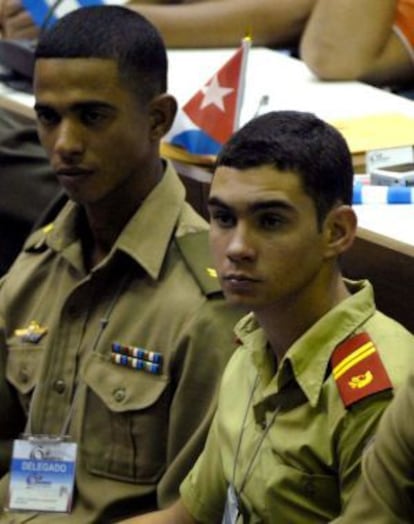Elián González travels from Cuba
The "boat child" turns 20 and travels outside of Cuba for the first time since 2000

Elián González was six years old when the aluminum boat in which he was traveling from Cuba, together with his mother and another 10 immigrants who did not survive the crossing, capsized before reaching American shores. After days hanging onto a tire's inner tube in the Straits of Florida, Elián, who was taken out of Cuba without the consent of his father, was rescued by a pair of American fishermen. It was November 25, 1999. What followed was a seven-month custody battle between the paternal granduncle who lived in Miami and the father who lived in Cuba. The controversy involved the United States Congress and federal courts and highlighted the political differences between Washington and Havana. Both parties took on the cause like a Cold War era crusade. On December 6 of this year, Elián González turned 20 years old and this week he left the island for the first time since that episode. González is taking part in the Cuban delegation attending the 18th World Festival of Youth and Students in Quito. The participants discuss the global fight against imperialism and defend the legacy of the Cuba Revolution.
The world remembers Elián González as the scared child staring at the muzzle of an MP5 semiautomatic rifle held by a federal agent while one the fishermen who rescued him, Donato Dalrymple, tries to shield him. Alan Díaz of the Associated Press took the photograph on April 22, 2000, the day that a commando unit from the U.S. Immigration and Naturalization Service stormed the house of Elián's granduncle, Lázaro González. The child, wrapped in a blanket, was taken and returned to his father, Juan Miguel González, at Andrews Air Force Base in Washington, DC. The military operation became the jurisdiction of the U.S. Justice Department after the relatives refused to comply with the order that denied asylum to the child.
Elián and his father remained in the United States until June 1, 2000, until their relatives in Miami had exhausted all possible avenues for appeals. In Havana they were seen as heroes. The José Martí Anti-Imperialist Platform that stands across the street from the United States Interests Section in Havana was build during this time as a call for the child's return. Elián delivered his first speech there at the age of 11 and the square is still used for large scale public events. In Cárdenas, Elián's hometown, located about 150 kilometers from the capital, the government built the "Museum of the Battle of Ideas." The venue includes a room dedicated to the events related to Elián's return and houses a small statue of the child with his clenched fist raised in the air. Fidel Castro attended Elián's seventh birthday party and later personally handed him his first membership card for the Young Communist League on July 5th 2008. Elián became a revolutionary symbol.
When he turned 16 years old, Elián González joined the military academy. Two years later, with his olive green uniform on and red epaulettes flashing, he took part in a march to urge the U.S. for another liberation - that of five Cuban nationals accused of espionage. They were detained in the United States in 1998. Four of them are still in custody, serving 15-30 year sentences.
Elián has said he is prepared to die for the revolution and that he sees Fidel Castro a father figure. Now that he is an adult he reflects on his what his life would be like had he been left in the United States. "since the interests of imperialism are monopoly, industry development, financial growth, maybe I would have a lot of money," he said. "I could be manipulated like a toy... Who knows what the empire might do to keep its stories straight. They would have turned me into a political figure in order to manipulate me as they wished."
Translation: Dyane Jean François
Tu suscripción se está usando en otro dispositivo
¿Quieres añadir otro usuario a tu suscripción?
Si continúas leyendo en este dispositivo, no se podrá leer en el otro.
FlechaTu suscripción se está usando en otro dispositivo y solo puedes acceder a EL PAÍS desde un dispositivo a la vez.
Si quieres compartir tu cuenta, cambia tu suscripción a la modalidad Premium, así podrás añadir otro usuario. Cada uno accederá con su propia cuenta de email, lo que os permitirá personalizar vuestra experiencia en EL PAÍS.
¿Tienes una suscripción de empresa? Accede aquí para contratar más cuentas.
En el caso de no saber quién está usando tu cuenta, te recomendamos cambiar tu contraseña aquí.
Si decides continuar compartiendo tu cuenta, este mensaje se mostrará en tu dispositivo y en el de la otra persona que está usando tu cuenta de forma indefinida, afectando a tu experiencia de lectura. Puedes consultar aquí los términos y condiciones de la suscripción digital.
Últimas noticias
The complicated life of Francesca Albanese: A rising figure in Italy but barred from every bank by Trump’s sanctions
How Japan is trying to avert ‘digital defeat’
Half of Scotland is in the hands of 420 property owners
From digital curfews to blocking apps: How technology experts protect their children online
Most viewed
- Why we lost the habit of sleeping in two segments and how that changed our sense of time
- Trump’s obsession with putting his name on everything is unprecedented in the United States
- Charles Dubouloz, mountaineering star, retires at 36 with a farewell tour inspired by Walter Bonatti
- The Florida Keys tourist paradise is besieged by immigration agents: ‘We’ve never seen anything like this’
- Living in a motorhome due to soaring housing prices in Madrid: ‘I got used to it quickly, but I don’t idealize it’









































